|
Related FAQs: Moray
Eels, Morays
2, Moray
Eels 3, Moray Identification,
Moray IDs 2, Moray Selection, Moray Behavior, Moray Compatibility, Moray Compatibility 2, Moray Compatibility 3, Moray Compatibility 4, & Moray Systems, Moray Feeding, Moray Disease, Moray Disease 2,
Morays and other Eels
& Crypt, Moray
Reproduction, Freshwater Moray
Eels, Zebra Moray
Eels, Snowflake
Morays, Other Marine
Eels, Conger Eels, Freshwater Moray
Eels,
Related Articles: The
Zebra Moray (Gymnomuraena zebra), The
"Freshwater" Moray Eels, Freshwater Moray Eels
by Marco Lichtenberger, Non-Moray Marine Eels, Snake & Worm Eels,
Dangerous Marine Animals
The What, Where, Avoiding and Otherwise Dealing with Biological Stinger,
Biters, Pokers as a Diver.
Look, Don’t Touch. Dangerous Marine
Animals: An Overview
|
|
| by Robert Fenner |
|
Amongst the seas denizens that can potentially be harmful to divers,
there is a vast array of stingers, biters, venomous and poisonous
animals; ranging from microscopic to boat size organisms. Recognizing
them becomes easier with time diving as well as above water instruction;
and avoiding dangerous marines is mainly a matter of your dive skills in
buoyancy control and body awareness.
Here is presented a necessarily brief glance at some of the major
sources of scuba and skin-diving hazardous life to be best
un-encountered in the sea.
About Marine Microbes:
Unbeknownst to most all people are the many microorganisms that are
found in even the “cleanest” of seawater. There are some viruses,
funguses, bacteria (including Blue Green “algae”) and Protists in every
drop of the sea; sometimes a great deal; but most are innocuous to
humans; not being pathogenic (disease-inducing) nor even raising a rash
(dermatitis) on your skin from immersion.
Definitions: Dangerous How?
Getting chemically “stung” appears straightforward; as does getting
bitten, poked by sharp processes; but there is an ongoing need to define
toxicity in terms of poison versus venom. Poisonous situations arise
when toxic biological materials are ingested; when they are taken in by
mouth; whereas venomous occurrences are a matter of simple touch or
envemonized (via puncture). As an example, you can get stung (venom) as
well as poked by the spiny rays of Lionfishes; but they’re definitely
not poisonous. In fact, they’re delicious to eat.
|
Beware of the spiny portions of
Scorpionfish’s dorsal and pectoral fins,
but don’t pass on the opportunity to
consume their tasty flanks in entrée and
hors d'oeuvres offerings. Though
they have large heads, not much body
meat, Lionfishes and kin are very edible
fishes.
With the
invasion of two species in the tropical
West Atlantic, folks in the US are
learning what much of the world already
knew, Lions are delish!
Pictured; a Pterois volitans
off the Queensland coast.
|

|
|
There are several, from the Middle
English meaning “many” other venomous
fishes. For instance, a darling of the
marine catfishes, the Coral Cat,
Plotosus lineatus is very painful to
get stuck and envenomized via its
forward pectoral and dorsal fin spines.
Think about this next time you’re
crouching down low in front of a group
for a close up photo or video.
|

|
There are many other venomous organisms to be found in the sea and
amongst diverse groups. Several Octopus and some Cowries are notorious
for their bites and deadly injections.
|
Of the better known venomous
snails the Textile cone (Conus
textile), here in the Red Sea) and
Geographic cone have been known to cause
human deaths. They should not be handled
of course.
|

|
|
There are a few octopuses whose
bite is very venomous; but none likely
better known than the few species of
“Blue Rings”. Here a four inch bodied
Hapalochlaena lunulata scoots out of the
way of divers in Bali, Indonesia.
All
Octopodes can bite, not all are
venomous.
|

|
|
Oh ho! Imagine my surprise; when
after years of encouraging folks to put
Flamboyant Cuttlefish in their hand for
a photo, I came to find that they are
dangerously venomous!
Here’s a
female Metasepia pfefferi out hunting in
Mabul, Malaysia.
|

|
Punctures: Easily Done
Sharp processes are more the rule than exception as defense mechanisms
go for aquatic life. With or sans toxic venom, these wounds have the
very real potential for infection… and they REALLY hurt.
|
Tangs, Surgeonfishes, Doctorfishes
are delicious food fishes all over their
worldwide tropical reef distribution;
but spear fishers need beware of their
namesake scalpel-like caudal peduncle
(the part of the body right before the
tail fin) “tang”… A super-sharp saber
that these fishes can and do know well
how to wield. Shown, the tasty Kole or
Yellow-Eyed Tang (Ctenochaetus
strigosus) in Maui. A fave to shoot
and eat as it “makes its own oil” when
cooked whole in a pan.
|

|
|
Related Rabbitfishes, or perhaps
the better common name, Spinefoots are
also preferred human fare, and similarly
spiny. Their anterior dorsal and anal
fin rays are dangerously spiny and are
lifted into defensive action if would-be
predators or fishers get too close. Here
is the aptly named Siganus puellis in
Wakatobi; S. Sulawesi.
|

|
|
Oh, how few of us have NOT been
stuck by Sea Urchins…. Whether from
hapless drifting to the bottom, betting
pushed about by currents adrift at night
or trying our best to not get poked
while framing that keeper image or video
for posterity? Here is a non-toxic
Diadema antillarum in St. Thomas,
USVI, and the unwary author with a few
spines in his knee…
|
|

|

|
Biting: Rare, But Can Happen
The vast majority of incidents where divers are bitten are due to human
prompting. Feeding wild, predaceous animals of size (e.g. Sharks,
Barracudas, Moray Eels….) is a foolish and dangerous exercise.
|
A common customer at tropical West
Atlantic “shark feeds”, the Caribbean
Reef Shark, Carcharhinus perezii
waiting their turn for frozen, impaled
chunks of mostly the fish species below
doing what they do. There are places in
the world that hand feed sharks and
more. Make no mistake; sharks are not
domesticated… and can do make little
distinction twixt the food item being
offered and the object holding it.
|

|
|
Below; the largest and most common
member of the family (worldwide
distribution in warm shallow seas) the
Giant Barracuda; Sphyraena gigantea.
A whole one in the Bahamas and a close
up down in S. Sulawesi (Wakatobi).
Showing its impressive dentition. Are
attracted to shiny objects already; no
need to tempt by feeding.
|
|
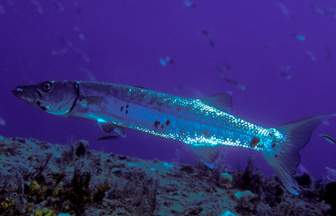
|

|
|
You’re in the mood for what? A
moray? These are wild animals; NOT able
to be made into pets. Every year finds
“mangled accidents” amidst well-meaning
divers and folks who just aren’t careful
where they place their hands. Do NOT
feed wild animals.
There are
smaller species (under a foot in
length), and some that eat crabs and
shrimps that lack sharp teeth; but there
are some humongous species that are
piscivorous… one, the Java Moray,
Gymnothorax javanicus (here in French
Polynesia, though found in Hawai’i, all
the way to the Red Sea) gets to some 3
meters/ten feet in length!
|
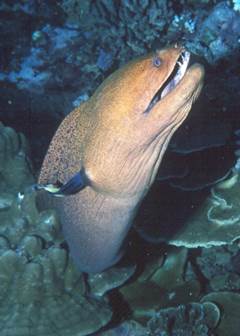
|
Stings A ‘Plenty:
Scratches, bruises, contusions and piercings from rough encounters with
the living and abiotic environment are all too common when you’re a new
diver, during night dives and in high current settings. Adding insult to
these physical injuries is the realm of stinging; and this is a HUGE
category.
|
Amongst the most familiar
diver-stingers are the Hydrozoans;
small, polyped kin of corals, sea fans
and other Cnidarians. At right, the
all-too familiar Fire Coral, Millepora.
Worldwide in tropical seas. Below; one
of the “Christmas Tree” like Hydrozoans,
Aglaophenia, and the author’s arm
after coming in contact; not paying
attention while making photos in Bali in
2014.
|
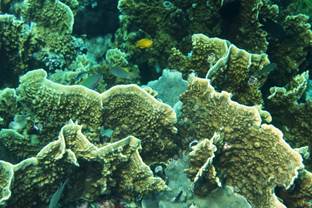
|
|
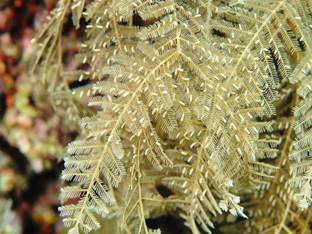
|

|
|
And of course, the many
Scyphozoans, “Jellies”; Medusoid animals
that can pack a wallop even if you don’t
see them. Here’s a stinging Nettle,
Chrysaora quinquecirrha at a British
Columbia Aquarium.
|

|
Combo! Bites/Spikes PLUS Venom!
Yes; there are animals that render venom through their biting humans;
albeit almost always in defense. These dual threats range from not so
serious to possible real trouble. We’ll mention by example, the range
here.
|
Fang-Tooth Blennies aren’t often
recognized for their danger to divers;
until you’ve been bitten! These little
(to about four inches) buggers have
sharp rear teeth that they use to ambush
other fishes, tearing off scales and
flesh for nutrition; and do “try out”
people at times; rarely with
consequence.
Shown; a
Plagiotremus ewaensis in Hawaii.
There are several other species of
Sabretooth Blennies in Indian and
Pacific Oceans.
|

|
|
Seasnakes similarly have small
heads with fangs toward the back of
their throats; and are even less
inclined to bite divers; but
occasionally someone gets too close and
gets stuck between their fingers. Here
is a Laticauda laticauda in
Bunaken, N. Sulawesi.
|
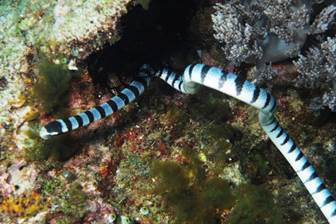
|
|
Of the more than eighty known
venomous species of Echinoderms (spiny
skinned animals), the toxic Sea Urchins
are way under appreciated. I have seen
many divers picking them up underwater,
perhaps believing that due to their
shorter spines that they’re not
dangerous. Not so. These Echinoids can
both puncture your hand and envenomize
you painfully. Shown; a Toxopneustes
pileolus in Puerto Vallarta, Mexico’s
Pacific side.
|
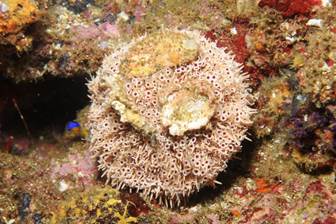
|
|
Many folks get poked and painfully
injected while “trying to save the
reefs” in well-intended Crown of Thorns
Starfish collecting efforts. Other than
Triton Snails (Charonia) and some
predaceous small shrimps; there’s not
much to counter the C o T periodic
population explosions and stony coral
predation. Do not touch with your bare
skin!
Shown: an
Acanthaster planci in Kona,
Hawaii.
|

|
Back to Poisoning: Ciguatera and More!
As I’ve mentioned; poisonous refers to ingesting toxic organisms.
Poisonous fishes in particular are common in tropical reef areas around
the world. The general term given to their toxic ingestion is Ciguatera
poisoning. There are a bunch of defining terms here; some for the target
tissues affected by their biotoxins (neurotoxin for the nervous system,
hemotoxic for blood, cardiotoxic for the heart…).
Ichthyotoxism (poisoning from ingesting fish) is often linked to
bio-accumulation of toxins from “top” predators consuming fishes in turn
that forage on toxic algae. We’ll have more to say regarding this
category of danger in a piece dedicated to the topic; but suffice it to
state that these fishes, Ciguatera, shellfish poisoning and more can be
avoided by being informed by local folks. They will know what organisms
are poisonous to eat.
Cloze:
To avoid troubles underwater divers should be aware of hazards,
perpetually observant of their surroundings and, avoiding contact with
potentially or really dangerous marine organisms. The best course of
action is to avoid touching any organism period; as you will find that
there are many marines that can cause humans woe.
In successive articles we’ll review in depth the who and what of sources
of biological dangers one should be aware of, how to recognize and
hopefully avoid them; and in the event/s of contact, what course of
action one can and should take to alleviate pain and infection.

